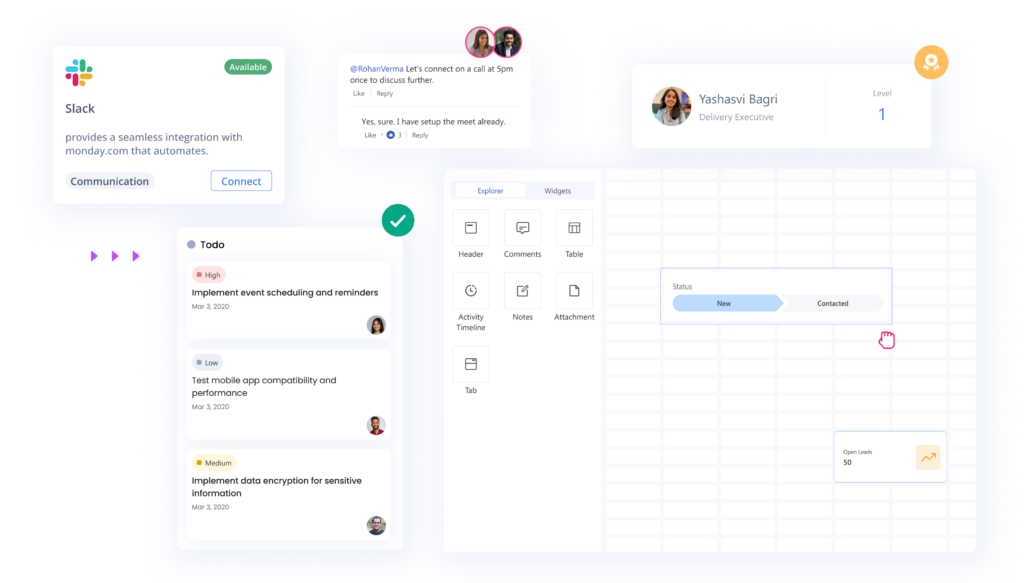
“A business’s true assets walk out the door every evening.” This smart and succinct quote captures a timeless truth of management – “people are the heart and soul of a business”.
Yet, people feel stifled at work, and IT systems fail to let them work at their best. Why? Traditional IT systems create a frustrating bottleneck because they’re expensive and rigid.
Low-Code platforms change this. Low-Code technology is a revolution that finally puts the power of digital transformation in the hands of the people who run the day-to-day operations. This is why it’s said that Low-Code is the marriage of democracy and digital. Let’s understand how a Low-Code platform works. But first, the basics.
What are Low-Code platforms?
Low-code tools are software development platforms that use visual interfaces instead of complex coding languages. Think of them like building with digital Lego blocks. You drag and drop pre-built components, connect them to create workflows, and add simple logic – all without needing years of programming experience. This is fundamentally different from how traditional IT develops applications – by writing line after line of code. But with Low-Code, a user has to focus on the application’s logical flow and functionality, not writing code. In fact, instead of coding, you’d use drag-and-drop components, configure settings, and define rules and workflows visually.
Anyone with almost no knowledge of coding can now develop applications themselves, using low-code platforms. Let’s consider this example.
Let’s say you need a shared workspace for your team to collaborate on projects. Traditionally, IT would need to build a custom application, which can be expensive and time-consuming. But with a low-code platform like Amoga, you can drag and drop pre-built components to create your own digital workplace. Imagine a central hub with tasks, calendars, document sharing, and real-time chat – all accessible from anywhere. Amoga empowers teams to skip the wait for IT and build the tools they need to work together effectively.

With Amoga, you’ll find such common use cases already done and you just need to customise them for your team. But that’s not all.
We have many other ready-to-use recipes that can make your organization digitally powerful like the best companies in your industry, but at a fraction of the cost. And there’s no limit to what you can develop – simply train your existing IT and entry-level developers in a month or hire Low-Code developers on-demand from Amoga, potentially at a cheaper price than your in-house resources. You don’t need to find experienced developers who are in short supply, as Low-Code development takes much less skill and time. The focus is on business logic instead of line-by-line coding.
This is the answer to the decades-old demand-supply gap in organisational IT.
How does Low-Code bridge the IT demand-supply gap?
Let’s understand this demand-supply gap – something that traditional high code methods are to blame for.
- On the demand side are people close to the work who know exactly what they need and why their productivity is stuck.
- On the supply side is IT, groaning under technical debt, constantly firefighting, and understaffed and underfunded.
This gap causes frustration, chaos, value leakage, and accumulating technical debt.
You see, the ones who know what solutions are needed can’t build them due to a lack of technical skills. And the IT team, though skilled, is overburdened and disconnected from evolving business needs. This creates a bottleneck. The consequences are grave: users are left waiting for critical solutions and waste effort on tasks that could be easily automated. Productivity suffers. Low-Code bridges this gap.
It does this in two ways:
- First, your non-tech employees can build applications for themselves and their teams by using Low-Code tools to build simple apps.
- Second, your IT team can develop complex solutions much faster using Low-Code, at 10x speed and 1/4th cost compared to traditional methods.
Technically, Low-Code abstracts away complexities and offers reusable building blocks. This allows even small IT teams to assemble robust applications rapidly by configuring, not coding from scratch. The result? You do more with less, work gets done faster, and solutions align tightly with evolving business needs.
But there’s more that explains why Deloitte estimates that by 2025, 75% of enterprise applications will be Low-Code. Let’s unpack these benefits that you can enjoy with a Low-Code platform like Amoga.
The benefits of Low-Code tools
1. 10X the speed of development
With Amoga’s Low-Code platform, you get the best of both worlds – simplicity and customizability. While it abstracts away coding complexities, you still have the flexibility to tailor solutions precisely to your needs.
For instance, imagine you want to automate your sales process with a custom workflow. Amoga provides ready-made templates to get you started quickly. But let’s say the default options don’t quite fit your specific requirements. No problem – you can simply modify the workflow rules, forms, and actions using Amoga’s intuitive visual builders.
The work that took a 10-member project team a month to do, can now be done by a 3-member team in a week. That’s 10x speed for your IT.
2. 1/4th the cost
Coding custom software is expensive due to high developer costs. Amoga flips this upside down. Your existing staff can build the solutions themselves with minimal training using visual tools. No more months of high consulting fees. You create what you need in-house rapidly and cost-effectively.
Let’s say you need a custom CRM tailored to your sales process. Having your own sales staff build it on Amoga could cost 75% less than outsourcing to developers. The cost-savings are so massive that no development request will die out because of lack of budget. With 1/4th the cost of automation, team leaders are compelled to think in a ‘digital first’ manner.
3. Reduced Shadow IT
Shadow IT is the use of unauthorised apps and services by employees. For decades, shadow IT has been a hard reality to grapple with for enterprises. Amoga’s Low-Code platform solves this problem.
Instead of sourcing unapproved cloud apps that IT has no visibility into, teams can use Amoga to rapidly build secure and compliant solutions they need. Solutions are developed on Amoga’s governed platform following centralised IT policies and standards.
For example, if the sales team needs a custom app to manage their pipeline, they can quickly build it on Amoga. The pipeline can have authorised access to CRM data, rather than using an insecure third-party app. This democratises app delivery while giving IT full control and oversight to mitigate shadow IT risks.
4. Simplified integration
In the past, integrating data and processes across different enterprise systems was a nightmare of complex APIs and coding logic. Amoga’s Low-Code platform makes it simple with visual integration builders.
For example, let’s say you want to connect your ERP system to a custom sales analytics app, while also pulling in marketing data from your CRM. With Amoga’s drag-and-drop integration designer, you can map data flows across all these systems visually, without wrestling with code. Simply configure pre-built connectors for each system, visually define the integration rules, and integrate rich functionality into your app with just a few clicks.
5. Enhanced security and governance
Data security, user access controls, and governance are top concerns for any enterprise application. With Amoga’s Low-Code platform, these are baked into the core architecture from the ground up.
At the platform level, capabilities like granular role-based access controls, data encryption, audit trails, version control, and policy enforcement are prebuilt. So when you develop an app on Amoga, these security and governance features are automatically inherited without extra coding effort. Your apps stay compliant and secure by design.
Imagine needing a client portal with sensitive data access. Amoga lets you control exactly who sees what. It also makes compliance easier with features like audit trails and version history, vital if you work in a regulated industry. Whether you’re an SMB or an enterprise, Low-Code is the bridge between the promise of digital and the reality of being digital.
Adopt Low-Code/No-Code in your work with Amoga
Low-Code is a mindset shift, and Amoga is the platform that delivers this shift to every member of your team. Low-Code works because it empowers your people to solve their own problems, frees IT to focus on innovation, and lets leaders build a company that can adapt as quickly as the world around it.
With Amoga you get:
- A blend of Low-Code and No-Code: Get the ease of use and speed of no-code, with the flexibility and customization of Low-Code when you need it.
- Security and reliability from day one: Amoga’s architecture prioritises data protection and stability.
- Productivity-focused features: Built-in analytics, task management, and collaboration tools help you achieve real results, not just build apps.
Ready to see Amoga in action? Contact us for a demo, let’s explore how we can transform the way you work.


